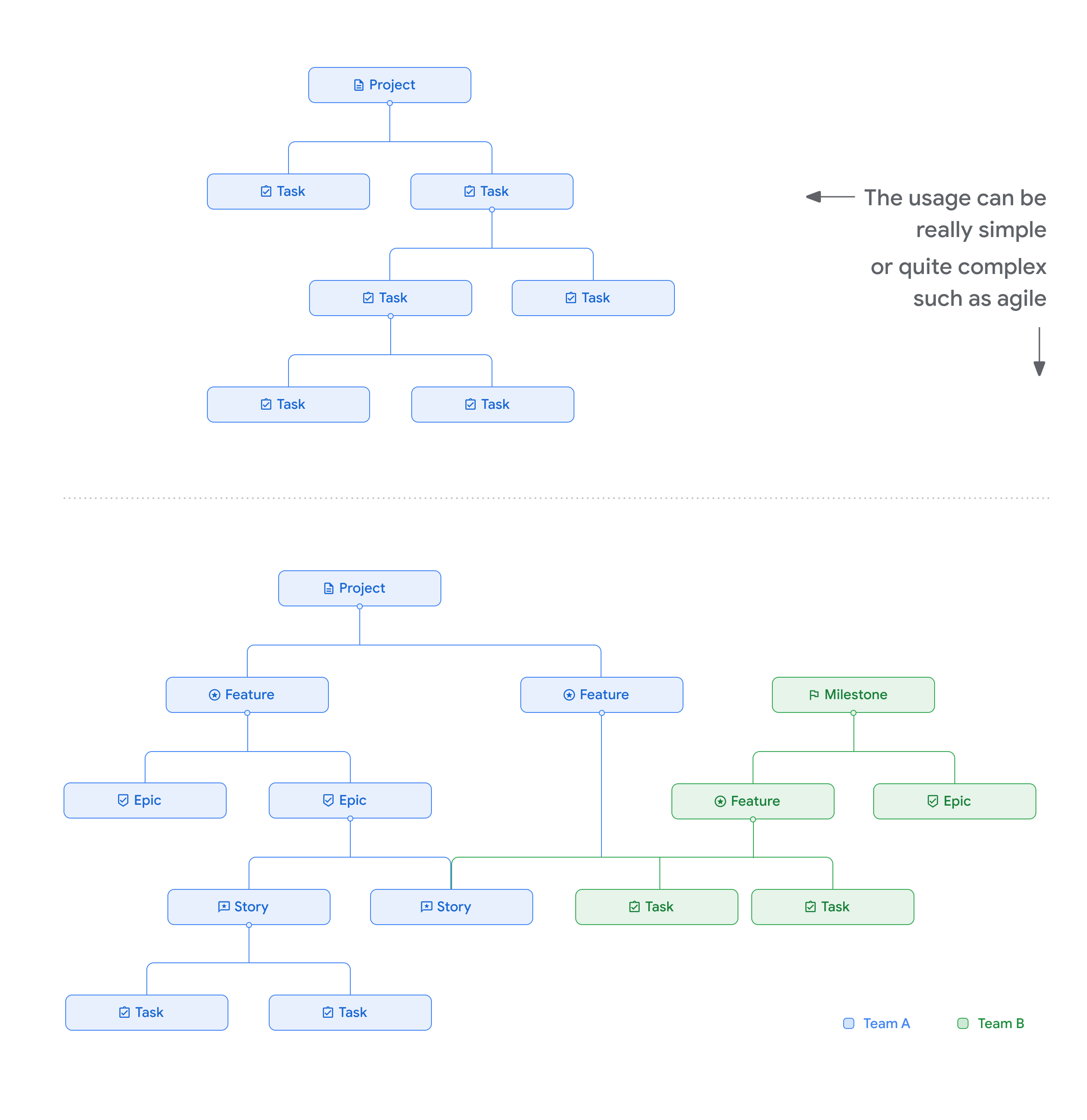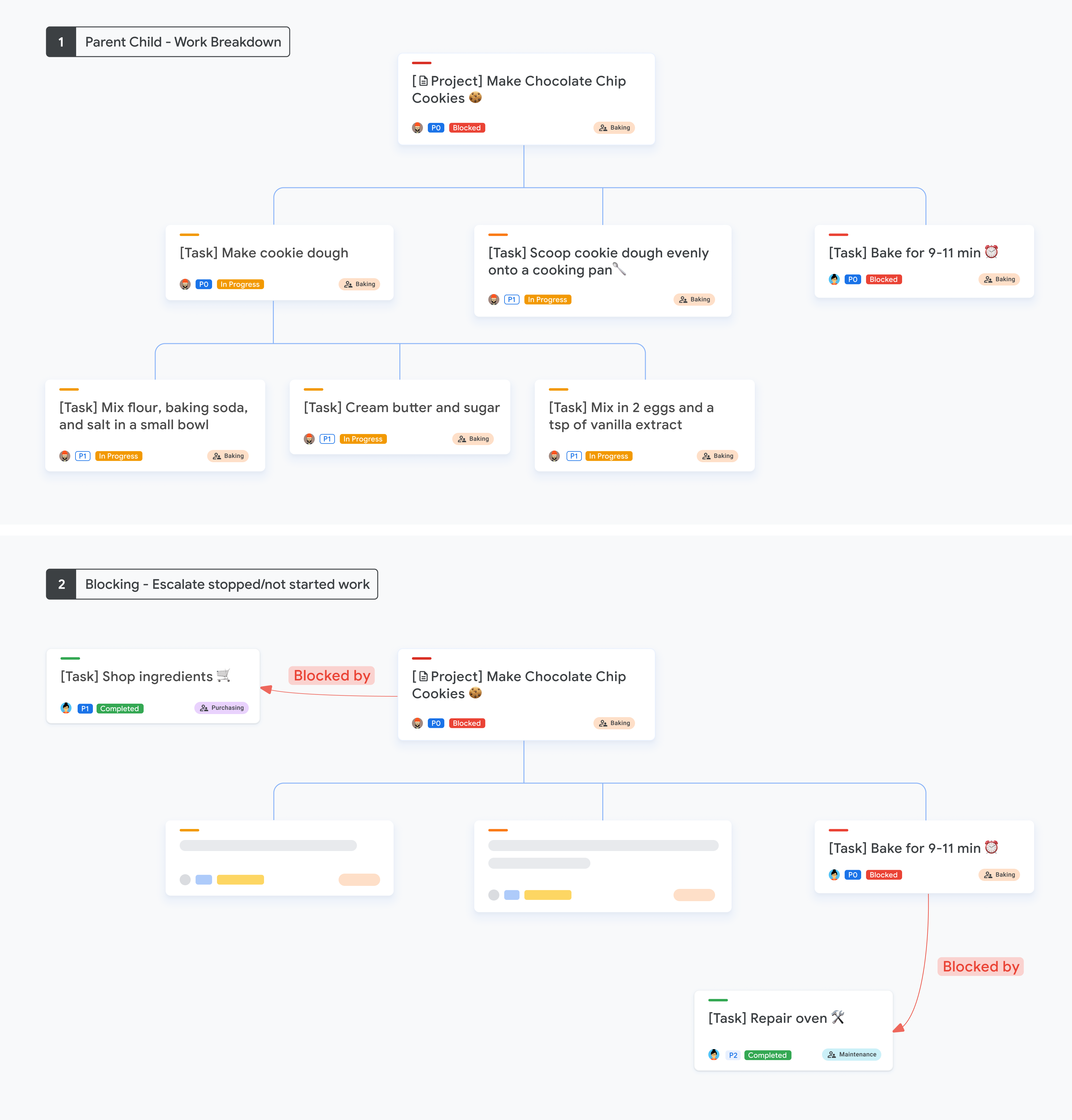ความสัมพันธ์แบบหลักกับย่อย
จัดทุกอย่างให้เป็นระเบียบอยู่เสมอด้วยคอลเล็กชัน
บันทึกและจัดหมวดหมู่เนื้อหาตามค่ากำหนดของคุณ
Google Issue Tracker รองรับความสัมพันธ์แบบหลักกับย่อย โดยทั่วไปความสัมพันธ์แบบ "หลัก-ย่อย" จะใช้เพื่อแสดงรายละเอียดของงานภายในความพยายามหนึ่งๆ รายการหลักอาจมีรายการย่อยได้หลายรายการ และรายการย่อยอาจมีรายการหลักได้หลายรายการ
ความสัมพันธ์แบบหลักกับย่อยมีลักษณะดังนี้
| ลักษณะ |
รายละเอียด |
| ความสัมพันธ์ |
N:N |
| การสั่งซื้อ |
ระบบรองรับการจัดเรียงรายการย่อยภายในรายการหลัก |
| การตรวจจับรอบ |
ระบบจะป้องกันไม่ให้มีการขึ้นต่อกันแบบวนซ้ำ |
| รายการที่ส่งออกโดยตรงสูงสุด |
500 |
| บรรพบุรุษสูงสุด |
1000 |
ตัวอย่าง
กราฟิกต่อไปนี้แสดงตัวอย่างความสัมพันธ์แบบหลักกับย่อย

ความสัมพันธ์ระหว่างผู้ปกครองกับบุตรและการบล็อก
ระบบจะยังคงรองรับความสัมพันธ์การบล็อกและถูกบล็อกโดยที่มีอยู่เมื่อคุณใช้ความสัมพันธ์หลัก-ย่อย เมื่อคุณรวมความสัมพันธ์ระหว่างผู้ปกครองกับบุตรหลานกับการบล็อก
- ใช้ความสัมพันธ์หลัก-ย่อยเพื่อแบ่งงานออกเป็นหน่วยเล็กๆ
- ใช้การบล็อกและการบล็อกโดยเมื่อการกำหนดเวลาและลำดับมีความสําคัญ และคุณต้องการระบุอย่างชัดเจนใน UI เพื่อส่งต่องานที่หยุดทำงานหรือยังไม่ได้เริ่ม
กราฟิกต่อไปนี้แสดงตัวอย่างรายละเอียดของงานระดับบนและระดับล่าง รวมถึงงานที่มีการบล็อก

สงวนลิขสิทธิ์ Java เป็นเครื่องหมายการค้าจดทะเบียนของ Oracle และ/หรือบริษัทในเครือ
อัปเดตล่าสุด 2025-07-25 UTC
[null,null,["อัปเดตล่าสุด 2025-07-25 UTC"],[[["\u003cp\u003eGoogle Issue Tracker enables the creation of parent-child relationships to represent the hierarchical breakdown of work within a project.\u003c/p\u003e\n"],["\u003cp\u003eIssues can have multiple parents and children, but the system prevents circular dependencies and limits the number of direct children to 500 and total ancestors to 1000.\u003c/p\u003e\n"],["\u003cp\u003eWhile parent-child relationships are ideal for structuring tasks, "Blocking" and "Blocked by" relationships should be used to indicate critical timing and sequencing dependencies.\u003c/p\u003e\n"],["\u003cp\u003eUsers are encouraged to leverage both relationship types to manage work effectively, using parent-child for work breakdown and blocking for highlighting time-sensitive dependencies.\u003c/p\u003e\n"]]],[],null,["# Parent-Child Relationships\n\nGoogle Issue Tracker supports parent-child relationships. A parent-child\nrelationship is typically used to represent the breakdown of work within a given\neffort. A parent can have multiple children, and a child can have multiple\nparents.\n\nThe parent-child relationship has the following characteristics:\n\n| Characteristic | Details |\n|-------------------------|----------------------------------------------------|\n| **Relationship** | N:N |\n| **Ordering** | Ordering of children within a parent is supported. |\n| **Cycle detection** | Cyclic dependencies are prevented by the system. |\n| **Max direct children** | 500 |\n| **Max ancestors** | 1000 |\n\nExamples\n--------\n\nThe following graphic shows some sample parent-child relationships.\n\nParent-child relationships and blocking\n---------------------------------------\n\nThe existing **Blocking** and **Blocked by** relationships are still supported\nwhen you use parent-child relationships. When you're combining parent-child\nrelationships with blocking:\n\n- Use **parent-child** relationships to break down work into smaller units.\n- Use **blocking** and **blocked by** when timing and sequence are critical, and you want to provide clear indications in the UI to escalate stopped or not started work.\n\nThe following graphic shows examples of parent-child and blocking work\nbreakdowns."]]
![]()
![]()
